There have been several interesting new discoveries about ancient life over the past month and I think I’ll start in a place that doesn’t usually spring to mind when you talk about paleontology. Scotland.
Now trace fossils, or ichnofossils as they’re technically known, are not the actual remains of ancient animals but rather the remains of their activity. Trace fossils can be anything from a burrow to fossilized feces, called a coprolite. The image below shows the track made by a trilobite as it crawled along the seafloor.
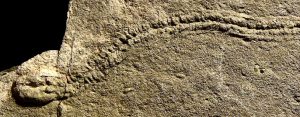
The best known type of trace fossils are of course Dinosaur Footprints! Well a recent discovery on the Isle of Skye in the Scottish Hebrides by paleontologists from the University of Edinburgh has brought to light more than fifty footprints from at least two different kinds of dinosaurs. The collection includes footprints from both a long necked, plant eating sauropod along with the two-legged meat-eating theropods. The image below shows one of the footprints for each of the sauropod and theropod.
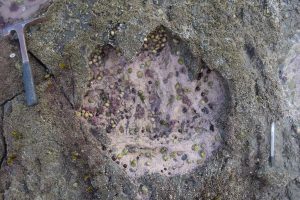
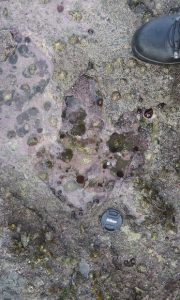
Back in the Jurassic period when the trace fossils were made the western islands of Scotland were a series of warm, shallow, soggy lagoons, a perfect place to leave footprints. By studying the footprints biologists can learn a great deal about the size, weight and even the gait of the animal that made them. The researchers estimate that the sauropod dinosaur measured two meters tall at its hip and was perhaps ten meters in length counting both its long neck and tail. They also believe that an early ancestor of the famous T-rex could have made the theropod tracks. The paleontologists hope to find more footprints on the Island and have even asked the local residents to keep a look out for them.
And speaking of carnivorous dinosaurs a new species has been identified from the Patagonia region of Argentina. Although the bones of Tratayenia rosalesi were unearthed a decade ago it is just recently that its discoverers, Doctors Domenica dos Santos and Ruben Juarez Valieri of the Museo de Ciencias Naturales in Argentina have identified it as a new species of a type of predatory dinosaur know as a Megaraptoridae.
Specimens of megaraptoridae have only been found so far in South America and Australia and they lived from the middle to late Cretaceous period. While Tratayenia rosalesi superficially resembles the famous T-rex (See image below) the skulls of megaraptoridae are longer and narrower and most importantly their arms are larger and much more powerful. (Remember how T-rex’s arms are such tiny, useless things.) I fact the megaraptoridae are probably more closely related to the velociraptor of the US southwest.
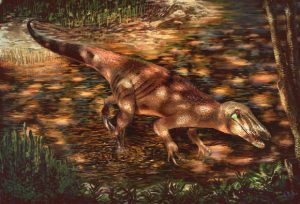
Only a few specimens of the megaraptoridae have been discovered so far and the researchers who found Tratayenia rosalesi hope it will tell us more about this interesting type of dinosaur.
My final story today doesn’t concern dinosaurs but rather is about their just as interesting contemporaries the Ichthyosaurs. The name ichthyosaur literally means ‘fish-lizard’ and indeed during the Triassic period a group of lizards returned to the sea and evolved into reptile versions of our modern porpoises and whales. Thousands of fossils of ichthyosaurs have been found and many different species have been described.
Now, the discovery of a bone from the lower jaw of a giant ichthyosaur from Gloucestershire in the UK has led a group of paleontologists to reevaluate other fossils from the same area that had been previously identified as ‘dinosaur vertebra’ but which may be other bones from a new species that could be the largest ichthyosaur yet discovered. The images below shows a typical, porpoise size ichthyosaur (by the way we do know that ichthyosaurs gave birth to live babies!) along with a complete fossil of one.
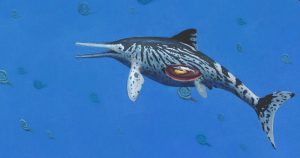
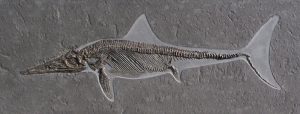
The researchers, led by Dean R. Lomax of the University of Manchester, estimate that the animal to whom the fossil bones belonged might have been as long as 26 meters. If that estimate turns out to be accurate the ichthyosaur would have been approximately the same size as a blue whale, the largest animal alive today.

Hello! I know this is kind of off topic but I was wondering which
blog platform are you using for this site? I’m
getting tired of WordPress because I’ve had problems with hackers and I’m looking
at options for another platform. I would be great if you could point me in the
direction of a good platform.
Thanks for the comment. I use wordpress and so far I like it!
Bob L
My brother recommended I would possibly like this web site.
He was once entirely right. This submit actually made
my day. You cann’t imagine just how a lot time I had spent for this information! Thanks!
Thanks for the comment and come back soon!
Bob L
excellent points altogether, you just received a logo new reader.
What would you recommend in regards to your
publish that you just made some days in the past?
Any sure?
Thanks for the comment and come back soon!
Bob L